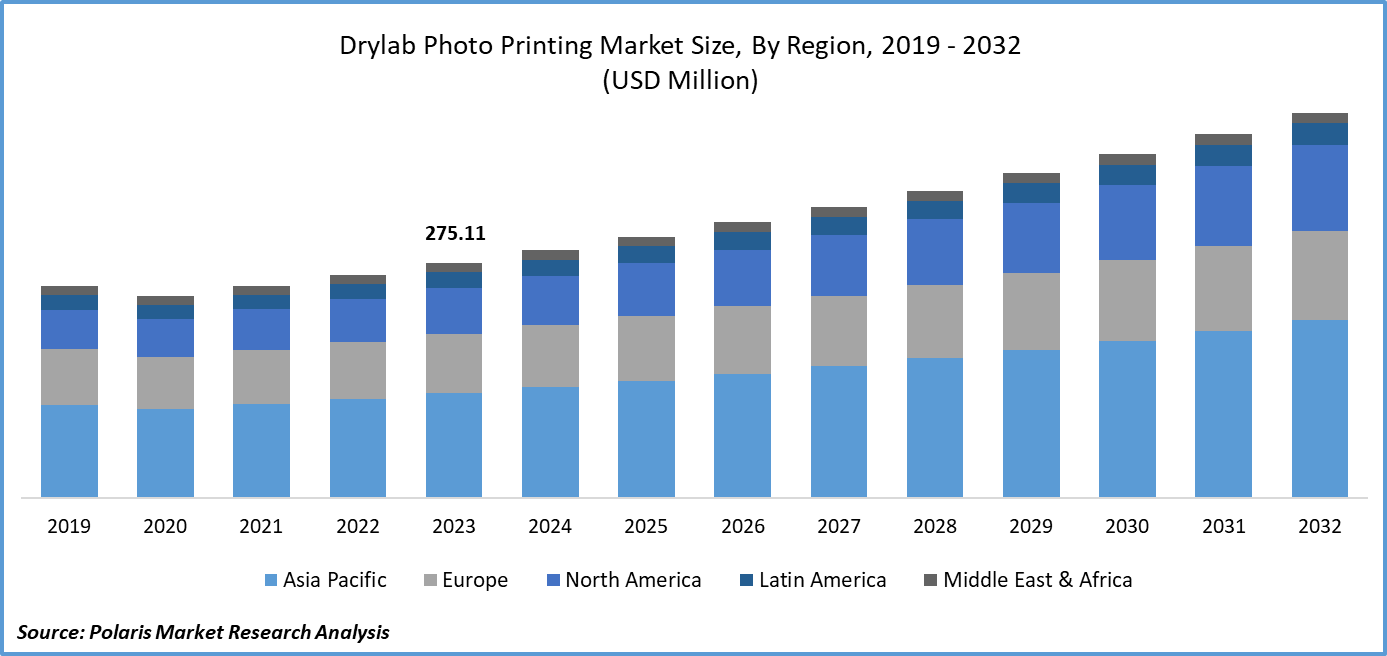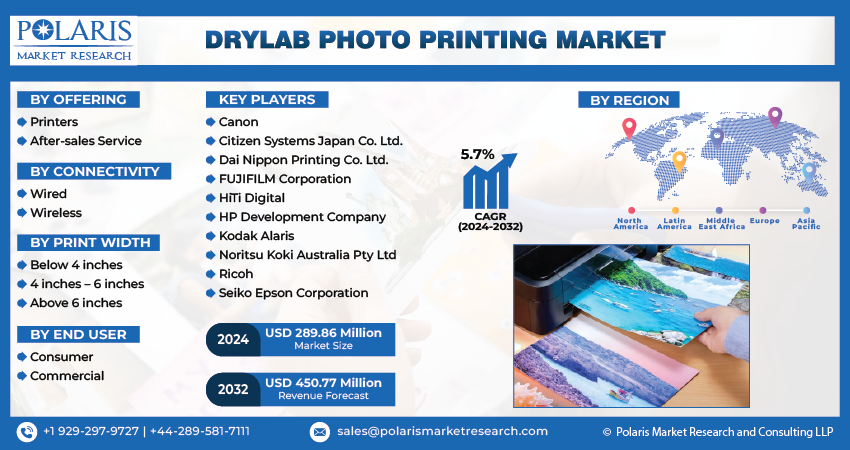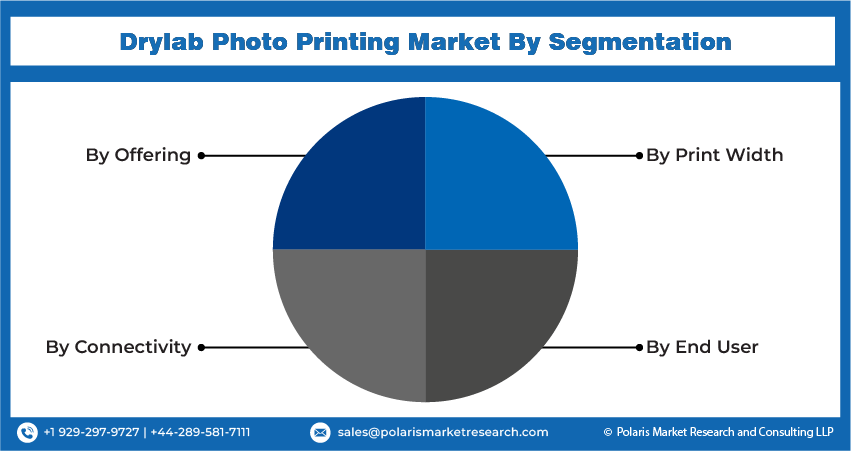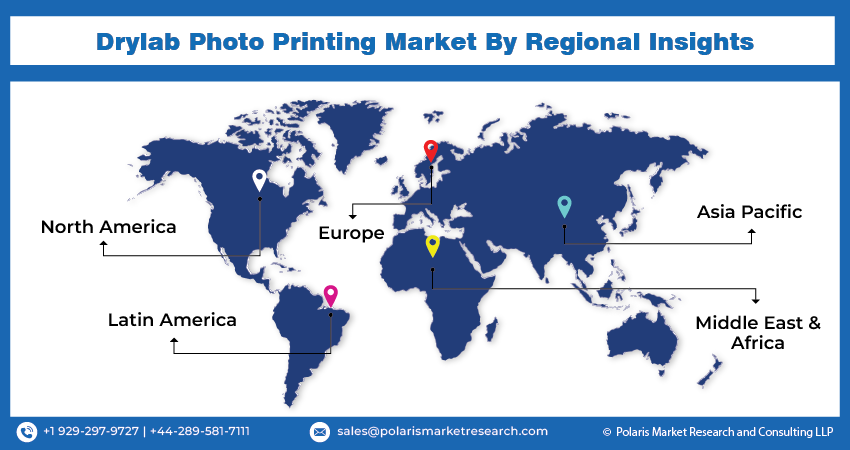
Drylab Photo Printing Market Share, Size, Trends & Industry Analysis Report
By Offering (Printers, After-sales Service); By Connectivity; By Print Width; By End User; By Region; Segment Forecast, 2025 - 2034
- Published Date:Jun-2025
- Pages: 130
- Format: PDF
- Report ID: PM4279
- Base Year: 2024
- Historical Data: 2020-2023
The global Drylab Photo Printing Market was valued at USD 289.86 million in 2024 and is projected to grow at a CAGR of 5.70% from 2025 to 2034. Despite digitization, niche applications in photo albums, ID cards, and specialty prints continue to support modest market growth.
Industry Trends
Dry lab photo printing, also known as digital dry lab printing or DLP, refers to the process of producing photographic prints without using traditional wet chemicals and darkroom techniques. Instead, digital images are printed onto special paper using laser or LED technology, resulting in high-quality photographs that are comparable to those produced through traditional methods. The process involves transferring digital image files to a printer, which then applies the image to the paper using a combination of heat and light.
The drylab photo printing market is significantly growing and has gained significant traction in recent years due to advancements in digital technology and changing consumer preferences. The drylab photo printing offers several advantages, such as faster production times, lower costs, and greater flexibility in terms of print sizes and finishes. One of the key drivers of the dry lab photo printing market is the increasing demand for digital prints. With the rise of smartphones and social media, consumers are clicking more photos than ever before and printing them to create a memory album, leading to an increased demand for high-quality prints. Dry lab photo printing provides an efficient and cost-effective way to meet this demand. Similarly, advances in digital printing technology have also improved the quality and speed of dry lab printing, making it a viable alternative to traditional wet processing methods.
- For instance, in January 2023, Epson introduced the SureLab D1070 and SureLab D1070DE drylab photo printer, specifically designed for event, retail, and e-commerce applications. This drylab printer is engineered to produce high-volume photo and graphic prints reliably and with high performance.

To Understand More About this Research: Request a Free Sample Report
Dry lab printing eliminates the need for expensive chemicals, water, and energy required for traditional wet processing, resulting in lower operational costs. Despite this, some restraining factors affect the growth of the drylab photo printing market. While dry lab printing is cost-effective in the long run, the initial investment in equipment and software is quite high, which acts as a barrier to entry for some businesses or individuals.
Key Takeaways
- Asia Pacific dominated the market and contributed over 42% of share in 2024
- By offering category, the printers segment accounted for the largest market share in 2024
- By connectivity category, the wired segment held the dominating revenue share in 2024
- By end user category, commercial segment held the significant market revenue share in 2024
What are the market drivers driving the demand for drylab photo printing market?
- The introduction of new advanced printing technology drives drylab photo printing market growth.
The introduction of new advanced printing technologies has played a significant role in driving the growth of the drylab photo printing market. With the emergence of digital printing, the traditional wet chemistry-based printing process is being replaced by more efficient and cost-effective methods. Drylab photo printing uses LED or laser technology to produce high-quality images on various media such as paper, canvas, metal, and other materials. This shift towards digital printing has brought about several benefits, including faster production times, lower costs, and increased versatility.
Also, advancements in digital printing technology have made it possible to produce large-format prints with exceptional quality. Another significant benefit of dry lab printing is its cost-effectiveness. Traditional wet chemistry-based printing requires a lot of resources, including chemicals, water, and energy. In contrast, digital printing uses LED or laser technology, which consumes less energy and produces minimal waste.

Which factor is restraining the demand for drylab photo printing?
- The initial investment in equipment and software is quite high, which limits market growth.
The high initial investment in equipment and software required to establish a dry lab photo printing business is a significant barrier to entry for potential entrepreneurs and small businesses. This includes the cost of purchasing specialized printers, software, and other necessary equipment, which can be prohibitively expensive for many individuals or small businesses with limited financial resources. Also, the cost of maintenance and upgrades for this equipment is usually high, further increasing the financial burden on business owners. As a result, the high initial investment required to start a dry lab photo printing business limits drylab photo printing market growth by discouraging new entrants and hindering the expansion of existing businesses.
Report Segmentation
The market is primarily segmented based on offering, connectivity, print width, end user, and region.
|
By Offering |
By Connectivity |
By Print Width |
By End User |
By Region |
|
|
|
|
|
To Understand the Scope of this Report: Speak to Analyst
Category Wise Insights
By Offering Insights
Based on offering analysis, the market is segmented on the basis of printers and after-sales service. The printers segment accounted for a significant portion of the total revenue generated by the drylab photo printing market in 2023, owing to the increasing demand for high-quality prints and the growing trend of personalized photography. With advancements in technology, consumers are now able to print their photos quickly and easily at home using high-performance printers that offer superior image quality and durability.
Leading players such as Canon, HP, Epson, and Brother have introduced innovative products with advanced features like wireless connectivity, mobile printing, and high-speed printing, which have contributed to the expansion of the printer market. These factors collectively have led to the dominance of the printers’ segment in the digital photo printing market.
By Connectivity Insights
Based on connectivity analysis, the market has been segmented on the basis of wired and wireless. In 2024, the wired connectivity segment dominated the global drylab photo printing market because of the high-speed and reliable connection that wired connectivity provides, which is essential for processing large files and data required for photo printing. The majority of professional photographers and photography studios rely on wired connections to ensure fast and efficient processing of images from their cameras or computers to their printers.
Moreover, wired connectivity offers greater stability and security compared to wireless connectivity, which is critical in professional uses where data loss or corruption can result in significant financial losses and damage to reputation. Additionally, many high-end photo printers available in the market require a wired connection to function optimally, further driving the demand for wired connectivity in the dry lab photo printing market.
By End User Insights
Based on end user analysis, the market has been segmented on the basis of consumer and commercial. The commercial end-user segment dominated the dry lab photo printing market due to several factors, such as photography studios, print shops, and advertising agencies requiring high-quality prints for their operations. They need to produce large quantities of photos quickly and efficiently, which can be achieved through dry lab printing technology. In addition, these businesses often have the resources to invest in advanced equipment and software that enable them to produce high-end prints with precision and accuracy. This level of quality is crucial for businesses that rely on visual content to promote their products or services.
Furthermore, advancements in digital printing technology have made it possible to produce large-format prints at an affordable cost. This has opened up new opportunities for businesses to create eye-catching displays that grab customers' attention. Large-format prints are used extensively in retail stores, restaurants, hotels, and other public spaces where they can make a significant impact. Dry lab photo printing allows businesses to produce these large format prints quickly and easily without compromising on quality.

Regional Insights
Asia Pacific
The Asia Pacific region emerged as the dominant player in the global dry lab photo printing market in 2024, and this was because of the growth and adoption of dry lab photo printing technology in the region. The Asia Pacific region is home to some of the world's most populous countries, such as Indonesia, India, China, and Japan, which have large consumer bases. This has led to an increased demand for personalized products such as photos, which are being driven by the growing trend of digital photography. As a result, there is a rising need for cost-effective and efficient methods of producing high-quality prints, which dry lab photo printing technology fulfills effectively.
North America
The North American region is expected to register significant growth in the forecast period because the region is experiencing an increasing number of photo retailers that are opting out the wet lab printers and preferring dry lab photo printers. Recent advancements in printing technology have paved the way for North American retailers to provide web-enabled printing services, which allow customers to order prints online from the convenience of their homes at a reduced cost without compromising on print quality. The trend of North American consumers printing photos at home is on the decline. In contrast, the demand for professional-grade, high-quality prints ordered online is on the rise, creating a vast drylab photo printing market opportunity for large-format media providers. Owing to all these factors, the North American market is expected to grow at a significant CAGR in the assessment period.

Competitive Landscape
The dry lab photo printing market is a growing industry, with several key players such as Epson, Canon, and HP Development Company competing for market share. Other players, such as Noritsu Koki Australia, Dai Nippon Printing Co. Ltd., and Kodak Alaris, have been competing fiercely with their lines of photo printers, further driving innovation and competition in the market.
Some of the major players operating in the global market include:
- Canon
- Citizen Systems Japan Co. Ltd.
- Dai Nippon Printing Co. Ltd.
- FUJIFILM Corporation
- HiTi Digital
- HP Development Company
- Kodak Alaris
- Noritsu Koki Australia Pty Ltd
- Ricoh
- Seiko Epson Corporation
Recent Developments
- In April 2024, Fujifilm launched two advanced inkjet printbar systems—the FUJIFILM DE1024 Digital Embellishment Printbar System and the FUJIFILM 42X Printbar System—at Drupa 2024, aiming to enhance high-resolution printing performance across commercial, packaging, security, and personal care applications.
- In October 2019, Dai Nippon Printing Co., Ltd launched DP-QW410, a new dye-sublimation digital photo printer that is one of the most lightweight and compact printers available in the market. It is specifically designed to cater to the needs of event photographers, photo booths, and ID photo solutions.
- In August 2022, HP Development Company accomplished the purchase of Poly, a company that offers workplace collaboration solutions. The acquisition was strategically made with the aim of providing a comprehensive portfolio of hybrid work solutions that will facilitate long-term sustainable growth.
- In November 2023, Dai Nippon Printing Co., Ltd. made an acquisition of land in Linwood, USA for the purpose of building a factory that will specialize in the production of battery pouches. These pouches will be designed to enclose and safeguard lithium-ion batteries.
Report Coverage
The Drylab Photo Printing market report emphasizes on key regions across the globe to provide better understanding of the product to the users. Also, the report provides market insights into recent developments, trends and analyzes the technologies that are gaining traction around the globe. Furthermore, the report covers in-depth qualitative analysis pertaining to various paradigm shifts associated with the transformation of these solutions.
The report provides detailed analysis of the market while focusing on various key aspects such as competitive analysis, offering, connectivity, print width, end user, and their futuristic growth opportunities.
Drylab Photo Printing Market Report Scope
|
Report Attributes |
Details |
|
Market size value in 2025 |
USD 306.38 million |
|
Revenue forecast in 2034 |
USD 508.17 million |
|
CAGR |
5.70% from 2025 – 2034 |
|
Base year |
2024 |
|
Historical data |
2020 – 2023 |
|
Forecast period |
2025 – 2034 |
|
Quantitative units |
Revenue in USD million and CAGR from 2025 to 2034 |
|
Segments covered |
By Offering, By Connectivity, By Print Width, By End User, By Region |
|
Regional scope |
North America, Europe, Asia Pacific, Latin America, Middle East & Africa |
|
Customization |
Report customization as per your requirements with respect to countries, region and segmentation. |
FAQ's
key companies in drylab photo printing market are Canon, Citizen Systems Japan Co. Ltd., Dai Nippon Printing Co. Ltd., FUJIFILM Corporation
Drylab Photo Printing Market exhibiting the CAGR of 5.70% during the forecast period.
The drylab photo printing market report covering key segments are offering, connectivity, print width, end user, and region.
key driving factors in drylab photo printing market are introduction of new advanced printing technology drives market growth
The global drylab photo printing market size is expected to reach USD 508.17 Million by 2032
